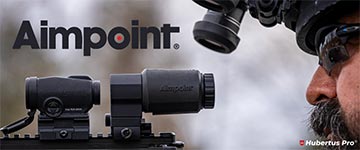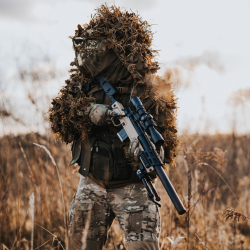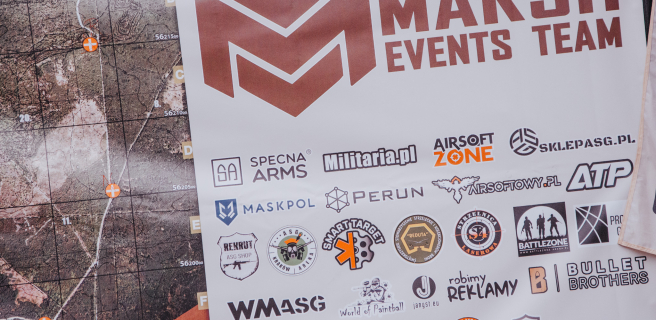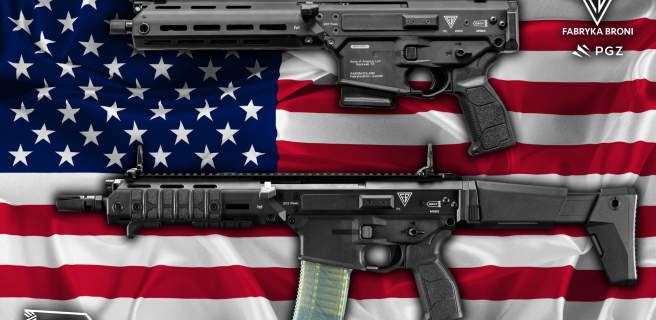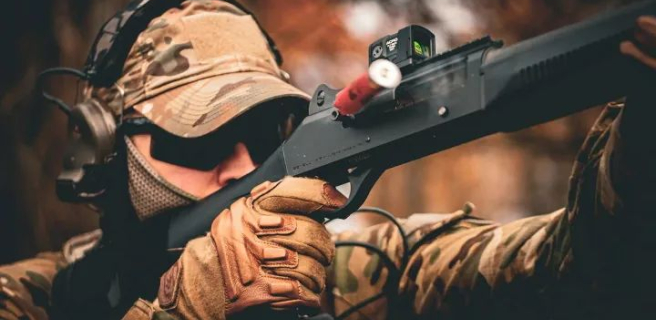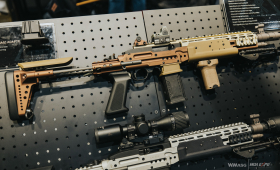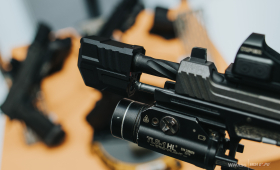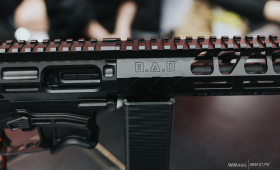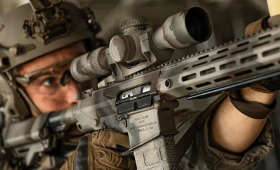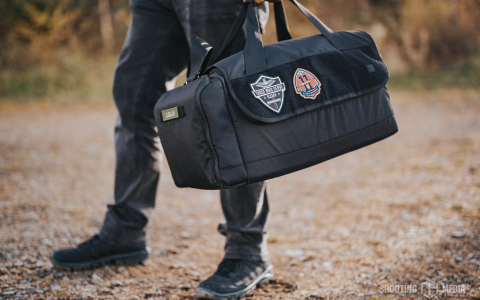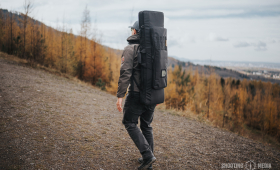INTRODUCTION
I had my first contact with the Fenix flashlights about 7 years ago, when I was working in a store with tourist and military accessories. I treated them as "nice flashing" and well made, expensive flashlights. In those days, the equipment of a reputable company "Police" was used at night airsoft games, necessarily with the largest number printed before the letter W. Who would then think about using flashlights that costed two, three, four hundred PLN?

Over the years and the popularization of increasingly efficient LEDs, I began to be more interested in Fenix products. It turned out that in addition to aesthetic design and a large luminous flux, these flashlights often offer something more - a clever idea. After some time, I decided to buy my first flashlight, specifically the TK35UE model, which uses the Cree MT-G2 LED. The amount of the luminous flux of 1800 lumens, as well as the pleasant colour of the light, meant that for the next two years this flashlight became the basic one used by me on the airsoft battlefield and beyond. At the same time, I also tried the E35UE flashlight using the XM-L2, which became my choice in the context of EDC.

Although both of these flashlights have already been replaced by other products, they are still in excellent condition and serve my friends well.
The following article will be devoted to one of the newer flashlights from the Fenix brand, the TK25 IR. This is the first of the flashlights I deal with (not counting the Chinese copies of the multifunctional AN-PEQ or DBAL), which in addition to generating white light, is also designed to support night vision systems, thanks to built-in diodes working in the 850nm infrared spectrum.

Although the name of the product itself might suggest something else, the TK25 IR flashlight does not work just an illumination for night vision equipment. It is also a full-fledged, compromise-free equipment used to generate white light, with a luminous flux value (according to the manufacturer's data) of up to 1000 lumens.
If you want to know more than read my test, in which, as usual, I will focus mainly on its airsoft application!
FENIXLIGHT LTD
Fenixlight Ltd, is a company founded in 2004 in Chine and is specializing in the manufacturing of high quality lighting. In particular, their known and valued products include handheld EDC, hunting, tactical, bicycle and head mounted flashlights.

The company's first successes came one year after it was founded and concern its first product, the L1+ flashlight, powered by 1 AA battery, which became one of the most interesting flashlights of 2005.
The following years Fenixlight introduced new products into the market and won subsequent awards, making it one of the most important companies in the industry.
PACKAGING AND ITS CONTENT
Is an attractive product packaging important? Not always, sometimes it is an example of the over-development of form over the content, because inside we find a product that is poorer and less delightful than the packaging itself. Some companies prefer to put their products into modest packaging, so as not to stimulate the buyer's imagination. Fenix seemed to have hit the sweet spot in this department. Their packaging is pleasing to the eye and just as well thought out as the product inside it. When opening the box, nobody should be disappointed.

However, everything in due time, first lets take a look at the box itself. It is made of plain cardboard, which has been covered with rich illustrations, descriptions and infographics. There is order here. The front part of the box presents the most important information: the appearance, name and basic features of the product. On the side you can find concise information about the holster that comes together with the equipment, while the back part of the box is contains a concise description of the flashlight itself, which allows you to get to know it well before making a decision to buy it.

Some of the more important pieces of information that are written there are:
- two CREE XP-G2 S3 LEDs are responsible for white light emission;
- both 18650 cells and CR123A batteries can be used as a power supply (the manual describes it in even more detail!);
- in IR mode, you can select 1W or 3W power setting;
- dimensions of the flashlight are 142.6mm (length), 25.4mm (tube diameter), 40mm (head diameter) and its weight is 156.5 g (without the battery and the clip);
- the set also includes a leash, a spare gasket, a belt holster, a mounting clip, a rubber band to protect the flashlight from falling out of the holster, a user's manual and a warranty card;
- the flashlight meets high resistance standards (protected against falling from 1m, it is dust proof and waterproof, IP68, up to a depth of 2m).
In addition to the information provided, there is a table showing available luminous fluxes and the times the flashlight can operate using them, as well as a graph detailing them (described in more detail in the paragraph "Use and operation").
The time has come to open the cardboard box.

Inside, we find all the parts of the set, including the flashlight and the belt holster, secured in a plastic bubble.
The belt holster is quite complicated, but thanks to it, a very practical part of the set. With the exception of the rubber band for additional flashlight protection, the entire holster is made of hard plastic (according to information from the manufacturer, it isnylon and fiberglass). As a result, it is a stable and reliable solution, no matter how and where it is mounted. In order to insert the flashlight into the holster, the head has to be placed in the ring at the bottom, and then the tube should be inserted into the space designated for it, secured with a flexible clamp. It is virtually impossible for the flashlight to fall out of such an holster, but if someone likes to be even more sure, he/she can additionally use the already mentioned rubber band by pulling it over the flashlight. The ring, to which the head is inserted, not only serves to stiffen and hold the flashlight, but also partially protects the glass protecting the emitters against damage. The manufacturer has drilled a large hole in this ring that provides the ability to use the flashlight without removing it from the holster. Maybe not entirely innovative, but certainly a clever solutions. And that's not all!



The second part of the holster is the buckle that fastens the holster to a belt. It is opened with a very well made button, which you will not press accidentally. Thanks to this, the holster can be attached not only to a trousers belt, but also to many other types of tapes, through which you can pull through a part with a width of 50 mm. Of course, in the interior of the belt compartment there is an additional, slightly springy part that tightens the holster to the belt in case it would be too loose. A very important question, are you planning to use a wide or narrow belt? This is, of course, a joke, the buckle can be widened or narrowed in four positions ( from 45 to 62 mm).


At the end an interesting feature. The holster is rotatable, in a range of 300 degrees, so you can carry the flashlight at any angle, except for a full turn upside down. This protection against the flashlight head moving from the ring intended for it, for example during running. Of course, the resilient holster and rubber band would prevent the equipment from falling out, yet still. This is already included in the kit by Fenix, marked as ALC-01 (also suitable for TK25 R&B, TK09, TK15UE, TK16 and TK20R models).



The other elements of the set are not so complicated. The safety leash does not differ much from ones added to the similar class of flashlights. It gives the impression of robust and has an embossed company logo.

The mounting clip is made of steel and is press-fitted. It is not intended for simultaneous use together with belt holster.

The warranty card describes in detail the warranty terms for which this model consists of:
- free exchange for another copy within 15 days, if the product has factory defects;
- the warranty period of 5 years, including the replacement of parts and repairs that are not due to user's fault, are free;
- lifetime post-warranty period, at this time unpaid repairs due to user's fault are made free of charge, the buyer covers the cost of parts;
- the possibility of extending the warranty period by 6 months, by registering the purchased product on the manufacturer's website.

The user's manual in several languages, unfortunately not Polish. Nevertheless, it is easy to understand. If my memory is correct, the Kolba.pl store provides its own Polish version of the user's manual with the purchased products. The instructions from the manufacturer contain a lot of information that other manufacturers often forget about and they are important from the user's perspective. Such information should include a detailed description of what types of power supply are supported by the flashlight. In addition to the cells recommended by the manufacturer (18650 Fenix ARB-L18 and ARB-L2), the flashlight works with:
- CR123A 3V batteries (2x);
- Li-Ion 18650 cells from other manufacturers with a voltage of 3.7V or 3.6V - the manufacturer recommends the use of high-quality protected cells;
- Li-Ion 16340 cells (2x, i.e. rechargeable cells with dimensions of CR123 and 3.7V or 3.6V) - recommendations as above.
It is forbidden to use LiFePO 18650 cells with a voltage of 3.2V.

The manual also contains information that the flashlight works with the AER-03 cable switch.
In the box I also found a modest leaflet advertising other Fenix products.
THE DESIGN
When looking at the overall design of the TK25 IR flashlight, it is difficult to see that it is a more complicated product than others on the market. Only two things seem to reveal its true nature, the shape of the reflector and the markings suggesting that the head can rotate. It is, however, worth starting from the beginning. The whole device is made of anodised aviation aluminum (type III), protected against abrasion. Thanks to its design and the quality of materials used, the flashlight is protected against falling from a height of 1 meter, it is also dust proof and waterproof, as the IP68 standard says (in the case of this flashlight, temporary immersion to a depth of 2 meters should not cause any damage). In the desing of the Fenix TK25 IR product, three main parts can be distinguished: the rear nut, the tube and the head.

The rear nut has a diameter of 25.4mm (1 inch). Its part is knurled, which facilitates a secure grip and unscrewing it. In the back of the cap there is a loop that allows you to thread the supplied safety leash. On the bottom there are two rubber buttons with non-slip texture. The shape of the buttons is different (the main one is round, the second one's shape and size resembles an oval), so that in limited light conditions you do not have to think which one to use. The rear nut gives access to the battery compartment. From the inside, it is finished in an aesthetic and will made way, as shown in one of the photos. The threads work well and almost silently with each other.



The tube of the flashlight is almost entirely knurled and has a diameter of 25.4mm. This means that you can successfully apply many types of mounting rings for this product, dedicated to both flashlights and aiming scopes with 1" tube diameter. With the exception of a small white dot which, in conjunction with the markings on the head, indicates what kind of diodes was chosen for use, there are no other markings on the whole tube. The tube ends with an external thread to which the rear nut is screwed on. The thread is made precisely and secured with a rubber gasket. Inside the tube is the battery compartment that has been made in black.




The Fenix TK25 IR head is a more complicated element. Its diameter is 40mm, and the texture is smooth with a few very shallow groves. Here, all markings of the flashlight are placed, which include the manufacturer's logo and model name, the markings of European standards, a warning against the possibility of heating up and the invisible (yet perceptible) for the human eye infrared light. At the bottom of the head there are spaced by 90 degrees, are the "W" (white light) and "IR" (infrared 850 nm) markings, which together with a white dot on the tube indicate the selected lighting mode. The head is, of course, crowned, which provides protection for the protective tempered glass coated with an anti-glare coating. Underneath the glass you can see two smaller, smooth reflectors (the SMO type - they provides greater light focus at a longer distance), at the bottom of which there are two CREE XP-G2 S3 LED emitters. Together they generate white light with a total luminous flux of up to 1000 lumens. Where does the infrared light come from?



The head can be rotated in the full 360 degrees range and locks every 90 degrees. It is in this way that the LEDs used are changed.



The rotation of the head serves not only for the electronic disconnection of the source of white light, but also for the mechanical replacement of LEDs. If anyone wondered why Fenix TK25 IR reflectors look like this, then his doubts should be resolved. The head has four alternating emitters: two white lights and two infrared lights. The reflectors only reveal one type of diodes at a time. It is worth mentioning that in order to lose as little light as possible, the LEDs are pushed into the reflector. When rotating the head, it extends by a few mm forward (for a fraction of a second extending the flashlight) to move the reflector away from the emitters and allow the second type of diodes to be inserted into the reflectors. It starts to get interesting, right?
USE AND OPERATION
Thoughtful solutions in the Fenix TK25 IR flashlight are not limited to its design. The flashlight's controller also has various functions to make the use of the product more efficient.

In order to prepare the flashlight for use, you must unscrew the rear nut, insert one of the supported types of batteries, with the plus pole in the direction of the head, and screw the rear nut back on. The manufacturer gives the following operation times in individual modes (using the 18650 Fenix 3.6V 3500mAh battery):
- 2 hours in turbo mode (the maximum 1000 lumens);
- 5 hours and 20 minutes in high mode (300 lumens);
- 22 hours and 20 minutes in medium mode (100 lumens);
- 110 hours in low mode (15 lumens);
- the operation time in stroboscopic mode (1000 lumens) is not given.
The times of operation in the IR mode are also not provided. However, it can be assumed that at 1W-3W, the battery will last for at least a few hours of continuous use.

The graph attached shows that the flashlight controller in most lighting modes maintains the desired brightness almost all the time, until the battery is discharged. The exception is the turbo mode - in this case, the brightness of the light is systematically dropping (1000 lumens are possible only on a fresh battery, and after about 90 minutes the luminous flux falls below the value of 300 lumens).
As it has already been shown, the flashlight has 5 different lighting modes. According to the manufacturer's information:
- the turbo mode (maximum 1000 lumens) reaches a distance of 225 m;
- the high mode (300 lumens) reaches 124m;
- the medium mode (100 lumens) reaches 75m;
- the low mode (15 lumens) reaches 25m;
- the strobe mode, like the turbo, is a maximum of 1000 lumens.
In the IR mode, the torch works with two power settings to choose from: 1W and 3W.
Operation of the Fenix TK25 IR flashlight, despite its diversity, is very simple. It is due to the controller, the rotating head and two physical buttons that activate the flashlight.
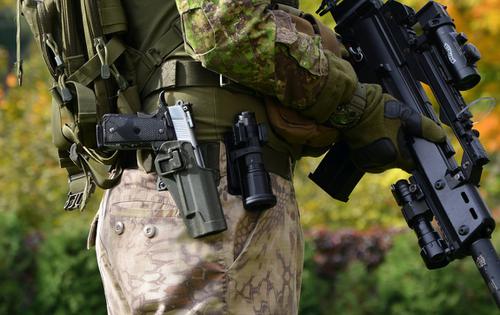
Short version of operating the flashlight. In the white light mode:
- pressing the main button (round) turns the flashlight on and off;
- partial pressing of this button starts it in temporary mode, until the switch is released;
- with the flashlight switched on, pressing the smaller button changes the lighting modes in the cycle: low -> mid -> high -> turbo -> low (...);
- with the flashlight switched on, holding the mode change button for about a second, activates the strobe mode until the next time the button is pressed or the flashlight is turned off;
- pressing the mode change button from the switched off position of the flashlight, activates the strobe in temporary mode;
- after switching off the flashlight, the controller remembers the last used mode (except for the stroboscope).
In the infrared light mode:
- pressing the main switch activates the illuminator in the 3W setting;
- partial pressing of this button starts it in temporary mode, until the switch is released;
- with the flashlight switched on, pressing the smaller button changes the modes: 1W -> 3W -> 1W (...);
- with the flashlight switched off, pressing the mode change button starts the flashlight temporarily mode (3W setting);
- the controller does not remember the last used mode (the illuminator always starts in the 3W power mode).

It is now time for the usual "what would happen if":
- when the flashlight is activated in the stroboscopic mode (permanent), pushing the mode change button or switching off and switching on the flashlight returns it to the last used mode of continuous lighting;
- the stroboscopic mode is skipped in the usual mode change, it can be turned on only by holding down the mode change button;
- when the stroboscope is activated in temporary mode, pressing the main button (without releasing the latter) will switch the flashlight into a permanent lighting mode (this is the only way to activate the stroboscope permanently from the switched off position of the flashlight);
- starting the rotation of the head with the flashlight switched on, temporarily turns off the diodes until the rotation is completed;
- after switching from white light mode to IR and returning to white light mode again, the flashlight will activate the last mode used;
- after switching from stroboscopic mode to IR mode and returning to white light mode, the last continuous light mode will be used instead of the strobe;
- the flashlight will behave similarly after such a change from the temporary strobe mode, with the difference that after releasing the button the light will be turned off (this can be prevented by pressing the main switch first);
- after switching from IR light to the white mode and returning to the IR mode, the illuminator will always return to the 3W setting;
- in the IR mode, after activating the illuminator in a temporary mode, it can be prevented from switching off by pressing the main switch (similarly to running the stroboscope in the permanent mode, from the switched off position of the flashlight);
- it is not possible to start the IR illuminator in the stroboscopic mode.

It is worth noting that, as in some other Fenix models, the stroboscope is not monotonous. After initiating the mode, in cycles of about 2.5 seconds, it changes its frequency from fast to slow.
LIGHTING CHARACTERISTIC
The beam of the flashlight is clearly divided into main one and secondary one. The main beam has a cone of about 10-15 degrees, while the secondary beam has a cone of about 80 degrees. Although two diodes are responsible for the beam, this is not visible in practice, only at a very close distances one can see some irregularities in the light. I would describe the colour of light as very gently falling into cold white colour.

In the case of IR LEDs, it must be remembered that MOST but not all of the light is generated at a wavelength of 850 nm. The illuminatior generates a bit of light in a wider range, and its small part falls into the visible spectrum. For this reason, when using the IR mode, the diodes light up dimly yet clearly and leave a red glow on the reflector. This is quite normal for diodes with this wavelength.

In order to illustrate the brightness of the Fenix TK25 IR flashlight, I compared it to several other products. The results can be seen in the photos below. The photos themselves do not reflect how the lights look in reality.

The photos were taken using a Nikon D5100 camera, using the following settings: f / 3.5, t = 1s, ISO = 200.
For comparison, the following flashlights were used: Olight S10 Baton, Mactronic M-Force 1.1, Olight M22 Warrior and Olight X7 Marauder.


First, a photo of the area made during the day:

The conditions at night:

Mactronic M-Force 1.1, Luxeon TX White LED (320 lumens):
.jpg)
Olight S10 Baton, CREE XM-L2 U2 LED (400 lumens):
.jpg)
Olight M22 Warrior, CREE XM-L2 U2 LED (950 lumens):
.jpg)
Fenix TK25 IR, 2x XP-G2 S3 LED (1000 lumens):
.jpg)
Olight X7 Marauder, 3x XHP70 LED (9000 lumens):
.jpg)
There are several conclusions that resulted from this test. The flashlights with significantly lower luminous flux are unable to compete with Fenix in the area of effective lighting of an area. In comparison to the M22 flashlight (950 lumens), the Fenix TK25 IR is virtually identically. Both flashlights have a similar colour of light, and despite the use of other diodes and reflectors, similarly illuminate the area both in terms of intensity and angle of illumination. Well, for the X7 and 9,000 lumens, the comparison makes no sense. The photo is just to show you that there are stronger flashlights than this Fenix. To put it more seriously, the last flashlight from the comparison can not be mounted on a replica, because it is a different category of products. In the case of tactical flashlights, the Fenix TK25 IR is really nice.

Below are also illustrative photos of how the IR illuminator in the Fenix TK25 IR flashlight works. For the tests, a night vision device based on a second generation converter with the PVS-5 was used. Pre-existing conditions, the same as before.
The passive mode:
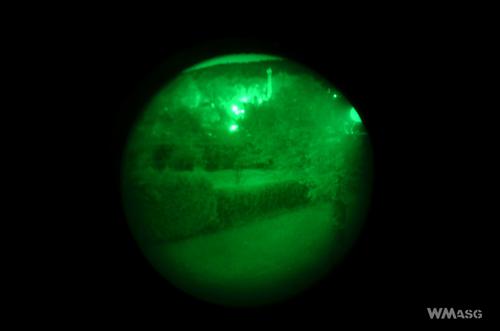
The Fenix TK25 IR, 3W mode:
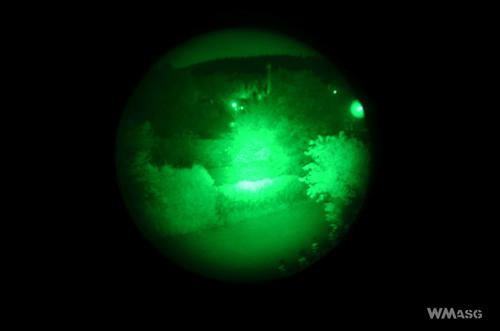
Unfortunately, I did not take a photos with the 1W mode, but during the tests the night vision equipment was behaving in the same way as with the 3W setting, practically not showing any difference between the two modes.

As the photos show, in the case of the second generation of night-vision goggles (and similarly in the case of the third generation) and the availability of residual light (half-moon on a cloudless sky, streetlights in the distance), using the illuminator is pointless. The autogating function of the night vision device compensates for the amount of light and, as a result, the illuminated objects become slightly more visible, but all this takes place at the expense of the quality and detail of the background. The object illuminated by the illuminator does not actually light up so intensely, it is a matter of the camera settings (long exposure time).
USABILITY IN THE FIELD
I had the opportunity to test the Fenix TK25 IR flashlight on two occasions unconnected with airsoft (in forest and urban areas), as well as on a 24-hour airsoft game called "Fedjet V4". During the first two, I focused mainly on the capabilities of the flashlight used as a handheld model or in the attached holster, while at the airsoft meeting it acted as the primary illuminator and flashlight mounted on the replica.

In the forest area, as a handheld flashlight, the Fenix product works perfectly, and the holster supplied with the set has a big part in it. I could write about how much I liked using it for a long time. The ability to mount the holster without unfastening the belt is a big advantage that will be appreciated, for example, when alternating between driving and walking around the terrain. Not one time did the the buckle open itself spontaneously. The method of inserting and removing the flashlight from this holster is very intuitive, fast and reliable, which encourages frequent use of it. In a situation where both hands are needed, the holster, turned by 90 degrees, is able to free the user's hands, not much worse than a headlamp.

Regarding the luminosity itself, the basic 15 lumens mode is enough to fully move around difficult terrain and see obstacles at a distance of about 15 meters. By increasing the value of luminous flux, visibility improves significantly until reaching the turbo level, which brightness in the first moments of illumination reaches up to 1000 lumens. In this mode, under favorable conditions (good air transparency and no obstacles such as bushes, leaves, etc.), the flashlight clearly illuminates objects at about 100 meters away. In an airsoft application, this is a sufficient distance to detect a threat before it enters its firing area. The residual light reaches much further, however, it is no longer intense enough to noticeably facilitate the perception of objects. In the case of using a flashlight in a dense forest area, the white light reflects from the closer branches and leaves, limiting the visibility of the further away (and in the case of the turbo mode, strongly weaning the eyes from the prevailing darkness).

I used the infrared light mode in the forest area for a very short time (in cooperation with generation 2 night vision device). At closer distances, switching it on was out of purpose for the reasons described in the "Lighting characteristics." Only in the open clearings, where the distance to the nearest obstacles reached about 200 meters, the use of the illuminator began to make sense. Considering, however, that in the airsoft it is rarely necessary to observe the enemy at night at such distances, in my opinion the illuminator of the Fenix TK25 IR model is unnecessary and rather unsuitable for users of the second or third generation of night-vision goggles.

The situation was different when I had the opportunity to use the illuminator for a brief time with the first generation night vision devices. Even in the case of distances up to about 50 meters, a 1W lighting mode was enough. Cheap, commercial night-vision goggles of this class are dealing very inefficiently with the reinforcement of residual light and need an additional light source for effective operation. In this application, the Fenix TK25 IR proved to be excellent, very effectively illuminating the surroundings and highlighting the details. Using an IR illuminator with a wavelength of 850 nm, it must be remembered that the red glow is very clearly visible to the naked eye from a distance of up to several dozen meters if you look directly at it. Obviously, this makes it difficult to remain undetected (it is worth approaching the the opponents from the side or rear), but this phenomenon is typical of all such types of illuminators.

What is the suitability of this equipment in rooms and conditions similar to typical airsoft CQB? As anticipated, 1000 lumens are much too intense, which allows you to use the flashlight also to distract the opponents and obstruct their aiming. Quick access to the stroboscope mode by pressing the change mode button is simply an ingenious solution! It really works and brings a lot of joy if only the user of this flashlight is on the right side of the barrel. However, it is worth taking care to protect the flashlight's glass from being hit, because there is a very good chance that a hit will break the lens. When choosing a protection method, one must remember about choosing the right material. The flashlight generates a certain amount of heat and obstructing its dissipation may not be healthy for the emitter.
Due to the power of the illuminator and concerns about the condition of my night vision transducer, I did not decide to test the IR illuminator in CQB conditions.
During the night airsoft game in the forest area, I had the opportunity to test Fenix TK25 IR in terms of ergonomics of its use on the mounting rail. In short, I have almost no reservations. The varied shape of the buttons makes it easy to distinguish them, there is also no problem with feeling them through the glove. Changing the white light mode to IR mode is instant and intuitive, however, you must remember in what position the head was left in. In the dark you can not see the markings or diodes, so it is impossible in any way to know if the flashlight is in IR mode or white light before switching it on.

To sum up, in the airsoft world this Fenix will be appreciated by enthusiasts of the night games and CQB. There is also a group of of airsoft players for which the TK25 IR seems to be an indispensable piece of equipment. These are the players who have first-generation night vision devices mounted on their replicas, who at the same time do not want to deprive themselves of the source of white light. The ability to mount just one device on a replica instead of two which, without any compromises, fulfills both functions, is an undoubted advantage. Especially in the case of operating in demanding terrain (where the low weight of the equipment matters) or having a replica in a system that does not offer too many mounting rails.
SUMMARY
The Fenix TK25 IR is undoubtedly a very competitive and innovative product. As it usually happens, there will be a lot of devices on the market that will offer similar parameters at a lower price. However, not ones that will combine the features of an efficient tactical flashlight and IR illuminator so well. For a set of two cheaper counterparts, i.e. a white light source with a luminous flux of about 1000 lumens and an IR illuminator, together with assemblies and power supply, you will have to pay about PLN 300. The Fenix TK25 IR costs half as much, but at this price the buyer also receives a longer warranty, an excellent holster and some great solutions that will be appreciated already at the first contact with the flashlight (e.g. quick access to the stroboscope or an intuitively programmed controller).

However, this is not all. In addition to the aforementioned advantages, there are also those that are more difficult to convert into monetary value. This device combines a flashlight and illuminator, and needs only one power source and only one mounting rail. In the case of replicas of weapons that do not have thousands of RIS rails in every possible place, this is a very important advantage. It may be equally important to save an additional 150g in the context of mil-sim games, during which players often go through tens of kilometers in full gear.
The Fenix TK25 IR is not free of defects, however, compared to many other flashlights with which I had contact with, these defects are really small. The biggest of them is the poor cooperation of the IR illuminator with night vision equipment of the second and third generation, which is caused by the excessive power of infrared light emitters. Who knows, maybe someday Fenix will release a version with a wavelength of 940 nm and weaker diode settings?

What is a disadvantage for some is an advantage for others. If you use or plan to purchase a first-generation night vision device in the future, and at the same time you love CQB, then the Fenix TK25 IR is a tool created for you.
Putting aside the issues of the infrared light, the Fenix TK25 IR treated even as an ordinary source of white light, does not deviate from the competition. The flashlight is well made and meets the demanding standards of watertightness and shock resistance. The brightness of lighting does not differ in any way from competing products (e.g. Solarforce L2, Olight M23, or Mactronic XTR).
So if you are looking for a universal device that would allow you to find a compromise between using white and infrared light (when using the first generation of night-vision goggles), the Fenix TK25 IR is the device worth your attention.
<u>I would like to thank the Kolba.pl store for making the Fenix TK25 IR flashlight available for the test.</u>

Pros:
- combines the advantages of two devices, i.e. a full-fledged tactical flashlight and an IR illuminator;
- 1000 lumens is still a lot;
- very intuitive and thoughtful operation (including quick access to the stroboscope);
- perfect holster that comes with the set;
- high standards of water resistance and protection against falls;
- very good performance;
- support for various power sources;
- long warranty;
- reasonable price.
Cons:
- poor cooperation with second and third generation night vision devices;
- in limited light conditions it is impossible to recognize whether the white light or IR light mode is selected;
- no power supply included.
USEFUL LINKS:
Fenix TK25 IR in the Kolba.pl store offer - Direct link to the flashlight model described in the text


